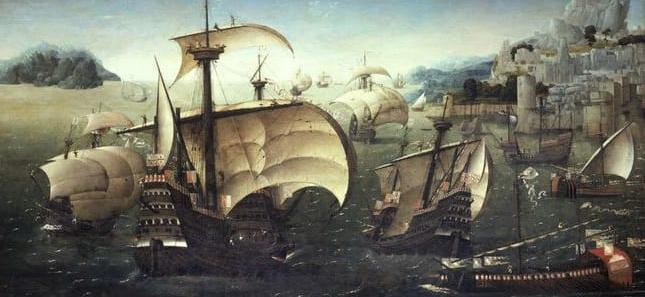 In 2010, we posted about the mystery of the “beeswax ship,” the wreck of a Spanish galleon that left shards of Chinese pottery and blocks of beeswax in the sand of an Oregon beach. Now, National Geographic reports that timbers from the ship believed to be the 17th-century galleon Santo Cristo de Burgos have been discovered in sea caves on the Oregon coast this week. The ship, sailing from the Philippines to Mexico in 1693 was lost when it veered off course and vanished. Its cargo included costly Chinese silk, porcelain, and blocks of beeswax for making candles.
In 2010, we posted about the mystery of the “beeswax ship,” the wreck of a Spanish galleon that left shards of Chinese pottery and blocks of beeswax in the sand of an Oregon beach. Now, National Geographic reports that timbers from the ship believed to be the 17th-century galleon Santo Cristo de Burgos have been discovered in sea caves on the Oregon coast this week. The ship, sailing from the Philippines to Mexico in 1693 was lost when it veered off course and vanished. Its cargo included costly Chinese silk, porcelain, and blocks of beeswax for making candles.
The extraordinarily rare hull remains were removed from sea caves near Manzanita earlier this week in a risky emergency recovery mission involving archaeologists, law enforcement personnel, and search-and-rescue teams from multiple state and local agencies.
Timber from the ship was first spotted by a beach-goer back in 2019. The pandemic and permit requirements slowed down the process, but archaeology firm SEARCH Inc., state parks and local agencies teamed up to pick up the artifacts this week.
The archaeologists agreed that the timbers were at risk of being swept out to sea, but extracting them from the sea cave proved to be complicated and dangerous. They only had about 90 minutes to document and remove the timbers before the tide would rise and trap them.
When the timbers were recovered safely and intact, the team felt a palpable sense of relief. “It was amazing to pull off such a complex operation, made entirely possible by teamwork, cooperation, and exceptional professionalism by all involved,” says Jim Delgado, the project’s principal archaeological investigator and senior vice president at SEARCH Inc.
The timbers are now at the Columbia River Maritime Museum in Astoria, where they’ll be carefully documented and conserved. Each timber will be scanned in detail, and the scans will be shared with Manilla galleon experts around the world to better understand how the extraordinary ships were built.
The Santo Cristo de Burgos was built in 1687-1688 at the Spanish shipyard of Solsogón on the island of Bagatao in the Philippines. The ship’s exact dimensions are not known, but the tonnage of Manila galleons increased over the years, as merchants wanted more cargo space for the lucrative trade to Acapulco. By the mid-seventeenth century, the Philippine shipyards were turning out galleons that had a 1,000-ton cargo capacity. Thus, it is likely that the Santo Cristo de Burgos had between 1,000 and 1,500-ton capacity, which would have been a fairly common size range at the time. Constructing such a large galleon required some two thousand trees, and the Philippines furnished forests of excellent hardwoods, including teak. Conscripted Filipinos did the toughest work of felling and stripping the trees, while other natives and Chinese craftsmen, under Spanish oversight, completed the construction and fittings.
The Manila trade route, maintained by Spain for 250 years (1565-1815), brought exotic Asian trade goods across the North Pacific to Acapulco in New Spain (now Mexico). It was a perilous, storm-ridden journey of some twelve thousand miles. Goods carried by the Manila galleons included embroidered and painted Chinese silks, lacquer furniture, ivory figurines, spices, Chinese fans, and Philippine cottons.
The captain of the Santo Cristo was Don Bernardo Iñiguez del Bayo y de Pradilla, a Basque nobleman from Tudela, Spain.
According to National Geographic, stories of the legendary shipwreck inspired Steven Spielberg’s 1985 movie The Goonies.
